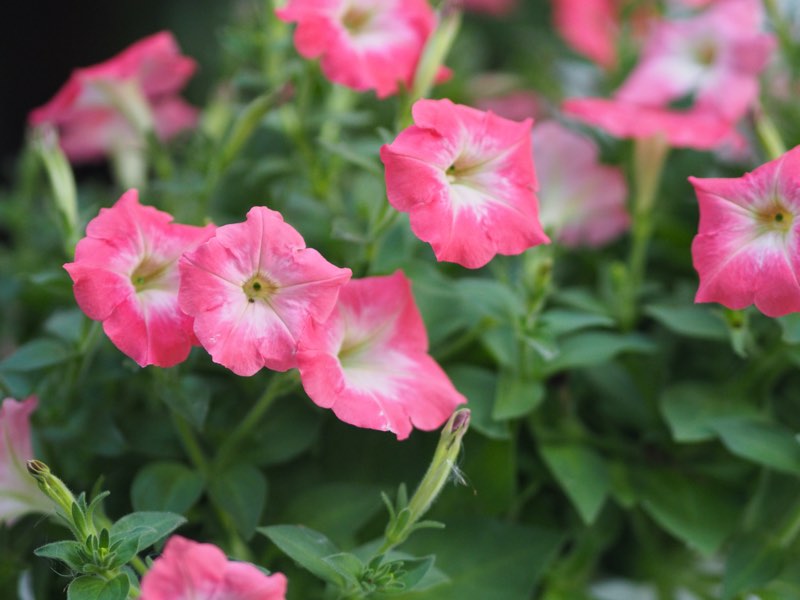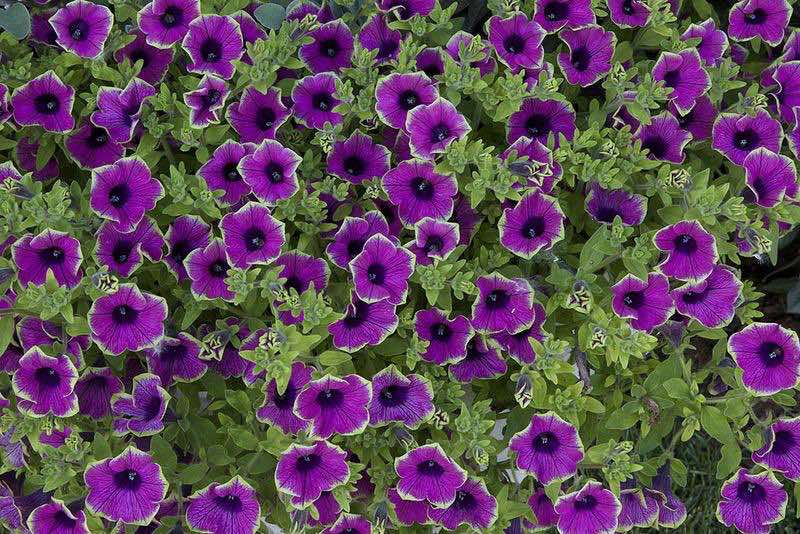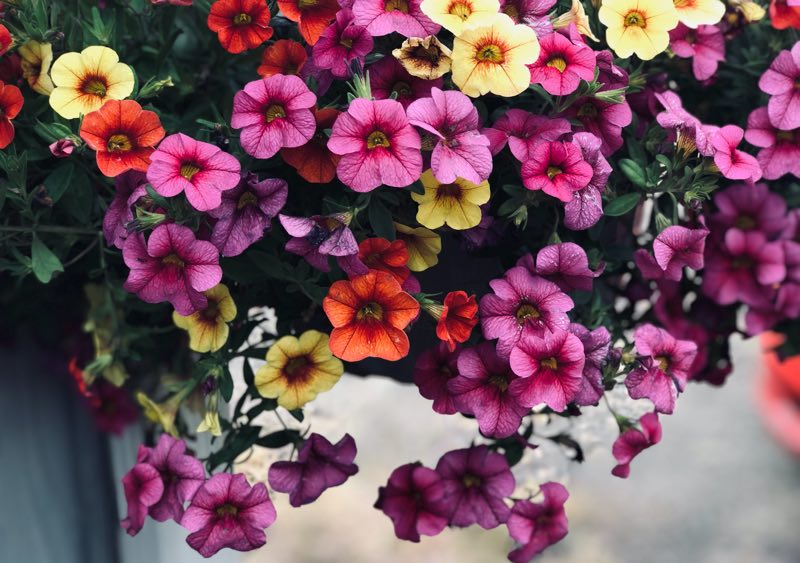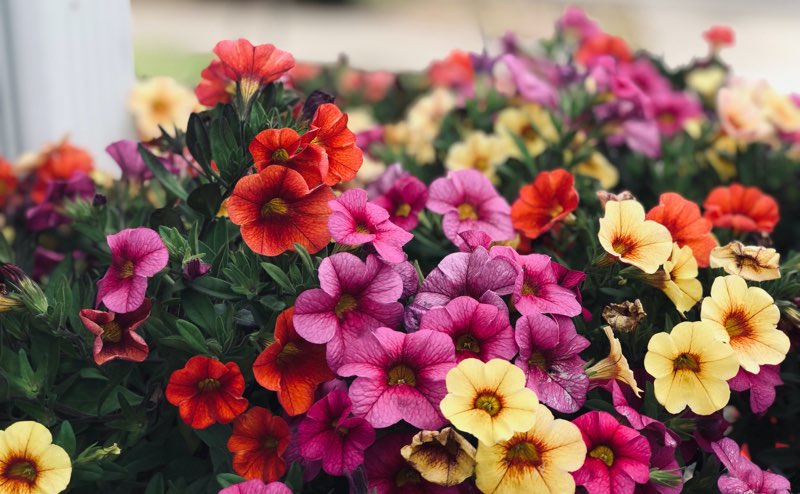Originating in South America but carrying a beautiful French name, petunias are often the ladies of the garden. They are colorful and delicate and know how to hold themselves in the gentle summer breeze. In this guide, we’ll share with you petunia growing and care tips and explore some of the most popular types of petunias.
Fast-growing and flowering with gorgeous, vividly colored blooms that enchant you, petunias are a must-have in any well-tended garden. Or at least that’s what we think.

Where do they come from, what types of petunias can you grow in your garden, and what do they symbolize in the language of flowers?
Find all you need to know about petunias in this definitive guide.
Petunia Flower Card
| Origin: | South America |
| Common name: | Petunia |
| Scientific name: | Petunia Atkinsiana |
| Rank / Species: | Hybrid |
| Family: | Solanaceae |
| Genus: | Petunia |
| Order: | Solanales |
| Height: | 12 to 18 inches |
| Blooms: | Single and double blooms that can reach 1 to 3 inches in diameter |
| Colors: | A wide variety of colors including pink, white, purple, and black; some are spotted |
| Foliage: | Pale to deep green, with a sticky and hairy texture |
Types of Petunias
If you’re new to the world of petunias, the first thing you need to know is that they are divided into four categories.
It is out of those four subgroups that you can choose the kind you like the most or that will fit your garden best. Here is the classification along with some examples.
Grandiflora Petunias
They are known for producing either single or double flowers that can grow up to 2-3 inches in diameter. You have probably already come in contact with them because these are the most common types of petunias available.

Grandifloras are perfect for window boxes or hanging plant pots because they tend to cascade beautifully as they grow and expand.
Popular varieties belonging to this subgroup include:
- Storm
- Daddy
- Dream
- Ultra
- Supercascade
- Supermagic
Multiflora Petunias
A lot more compact than the cascading grandi, multiflora petunias grow smaller flowers that reach 1 to 1 ½ inches in diameter.

They are perfect for every type of garden, but you will benefit from their small, beautiful flowers mostly if you plant them in tight containers. In this way, you can see them closely together.
Tip: Multiflora petunias will need to be deadheaded often to encourage production and blooming.
Here are some varieties we recommend:
- Celebrity
- Primetime
- Horizon
- Carpet
- Mirage
Milliflora Petunias
The blooms come in at around 2 inches in diameter and are an absolute crowd favorite.

This subspecies of petunias produces very bright and colorful blooms that are usually used as a color accent in gardens that need a little happiness.
Millifloras can withstand wind and rain very well, making them easy to grow in every climate. Two popular varieties are:
- Fantasy
- Picobella
Wave Petunias
Wave Petunias are also called spreading or ground cover petunias. They are not very tall, coming in at only 6 inches in height, but they can spread very widely, hence their name.

Fact: In one single growing season, these flowers can cover 4 feet. However, they will need a lot of water and weekly fertilization to keep up with all that spreading.
Since they tend to grow long, you can allow them to cover a sizeable patch of your garden. Or you can plant them in pots and have them hanging in a cascade.
Here are some popular examples:
- Avalanche
- Shock Wave
- Easy Wave
How to Grow Petunias
Learning how to grow these flowers depends on the types of petunias you want to plant in your garden.

Not all species of petunias react the same to soil or different temperatures, nor do they have the same requirements. So you really want to check the instructions for the specific variety (or varieties) you choose.
That said, here are some essential tips that are useful for every petunia type you may grow.
Growing Petunias from Seed
You are looking at some of the easiest annual flowers to grow in your garden, either directly in the soil or in containers. They can withstand almost any climate and caring for them is easy.
Below you can find the most important things to consider when growing petunias in your garden.
Temperature
You should be aware that petunias are not fans of frost, but they can grow in lower temperatures in case you live in that kind of climate.
They also don’t enjoy extremely hot weather which will cause them to stop flowering until the temperature has dropped a few degrees.

Tip: As a rule of thumb, most types of petunias enjoy being in the sun a lot.
However, if the temperature gets too hot or the sun is scorching, make sure to give them some shade as well. This will make them bloom better.
Soil
These flowers thrive in a slightly acidic soil that has been drained very well. The soil has to be very fertile and well-fed, otherwise, they will not bloom at all.
You may want to read more about soil types to figure out what soil you have in your garden.
Watering
Petunias love well-watered soils but don’t really like it when their roots sit in soggy soil. You have to be careful not to overwater them. But you don’t want to let the ground get dry, either.

Tip: Water them once a week, as deeply as you can, and allow them to drink that up first before returning to them with the watering can or water hose.
Fertilizer
You can use fertilizer to give your petunias a boost. They thrive on balanced fertilizers such as 12-12-12. In mid summer, you can use liquid fertilizer but no more than once every two weeks.
This is definitely the case for garden petunias that tend to spread and need all the nourishment they can get.
Diseases and Pests
The good news for every gardener who is in love with petunias is that they don’t require a lot of attention when it comes to diseases and pests. They are pretty resistant to invaders as far as flowers go.
Still, here are a few things that can happen to these flowers and what you can do about them.
- Soft rot or gray mold – There is no way to combat this. Choose varieties that are resistant to rot and mold in the first place to make your job easier. And, of course, don’t overwater them!
- Aphids – Hose your petunias down using a lot of water. It’s that easy! But again, make sure you don’t drown the roots. Good drainage will help a bunch.
- Budworm caterpillars – These little green caterpillars come out in July to feast on the flowers. You can leave them be. The insects usually disappear on their own later the same month.
Best Petunia Seeds
Passionate breeders all over the world come up with new types of petunias every single year. So, you have quite a lot of options when it comes to growing these flowers from seeds.

If you’re not sure whether to start, we recommend choosing one of the following:
- Supertunia Silver – The bloom in itself is almost white and it has a lavender core and veins. The color contrast makes it outstandingly beautiful.
- Blue Spark Cascadia – Violet flowers with a dark purple core that also give off a sweet scent.
- Prism Sunshine – This variety produces large, buttery yellow flowers that have a very good weather tolerance.
You can explore more seed varieties online. Here are some bestselling choices.
How to Deadhead Petunias
If you have your eye set on some of the newer types of petunias on the market, the instructions may say that you won’t need to deadhead them.
However, it’s often best to deadhead them anyway. This practice encourages them to bloom better instead of just producing seeds and makes them look even nicer.
Tip: The best time to deadhead your petunias is usually in mid-summer. The flowers will grow back more luxuriously and never cease to bloom.
So how do you do it?
Step 1 – Inspect Your Petunia Rows
Locate any dead or withered flowers. Keep in mind that some of them could still hold seeds even though they appear withered.
Step 2 – Start Cutting
Using shears or pruning scissors, cut the withered petunias right at the stem. This means beneath the bloom. You have to remove all parts of the flower itself, but you can leave some of the stem intact.
Step 3 – Trim the Plant
If the entire plant appears to have overgrown or to be leggy, you can reduce its size, but no more than half.
Tip: Don’t deadhead your petunias more than once a week. Allow the plants a bit of time to recover from the trimming.
If you don’t have a nice pair of deadheading sheers, try this useful tool:
Where Do Petunias Come From?
Today, petunias are considered common garden flowers, but this has not always been the case. In fact, these beautiful blooms have a long and tumultuous history.
Given the fact that they belong to the Solanaceae family, petunias are closely related to the potato, tomato, gooseberry, and chili pepper. But they are also cousins of the not-so-friendly tobacco and the deadly nightshade.
They were discovered in South America in the 16th century, during the reign of Queen Elizabeth I. In the native language of the local tribe, the flowers were called petun which roughly translated to a worthless tobacco plant.

This idea plus the fact that 16-century colonists found these colors to be quite unattractive (you can say that flowers are a matter of taste, like so many other things in life), made them not take any samples with them to Spain.
It was only after three hundred years that two separate explorers, one Scottish and one sent by the French King to South America, found petunias once more and sent samples to their countries in Europe.
Not only that, but one of them found a whole new species–Petunia the Violacea— that was purple.
In the late 1800s, breeders from Europe, America, and Japan became widely interested in the flower and started crossing samples in the hope of getting more colors.

This was how we got the petunias we know and love today, and which are considered to be hybrids of the original South American ones.
It’s also worth mentioning here that the process of crossing these flowers has not stopped since the 1800s. It’s still going on today, with specialists all over the world trying to invent the perfect blooms.
As a result, there are now over 100 types of petunias. For example, in 1983, a whole new class was created, which was called Floribunda.
Petunia Meaning: What Do Petunias Symbolize?
It’s no secret that every flower has a special meaning.
However, while you might be familiar with the more popular flower meanings–red roses mean love, snowdrops mean purity, and yellow roses are often a sign of jealousy–you might not be aware of the meaning of petunias.
The symbolism of this plant has changed over the centuries, just like the flowers themselves have changed.

As a result, years and years ago, they symbolized resentment and anger.
This could be a remnant of the fact that European colonists didn’t take a liking to them and refused to bring them back to their native England and Spain.
However, in more modern times, ever since the world has rediscovered petunias and just how beautiful they are, their symbolism has changed as well.

Growing petunias or gifting them to someone today symbolizes your desire to spend time with them because their company is soothing and calming to you. At the same time, these flowers stand for not losing hope.
Growing Petunias Commonly Asked Questions
We hear quite a few questions about petunias from gardeners, so we thought to bring these together in this section. The answers serve as a recap of some of the points we discussed above.
How to plant petunias?
Plant good quality seeds of a variety adapted to your region in a sunny spot that’s protected from the intense summer heat. Check our guide on how to grow petunias from seed for more tips.
How to deadhead petunias?
Deadhead them in mid summer to encourage beautiful blooms. Do it with sterile scissors or shears and without cutting too much of the plant in one go. Read our deadheading petunias guide for more advice.
What is the meaning of petunias?
Petunias symbolize friendship, the desire to spend time with someone, and not losing hope. Read more about petunia meanings through the ages.
Grow Yourself Some Petunias, Will You?
Petunias are some of the easiest flowers to grow in your garden, either directly in the soil or in containers. They can withstand almost any climate and don’t fall prey to pests and diseases.
When pruned and deadheaded correctly, they produce beautiful, vividly colored flowers that will be the delight of your garden.
So, you really have no reason not to grow them, especially after reading our guide on how to care for them.
Get started as soon as you get the chance and let us know how it goes, will you? And, of course, if you have any questions, drop them in the comments section. We’d be happy to answer them!

Leave a Reply